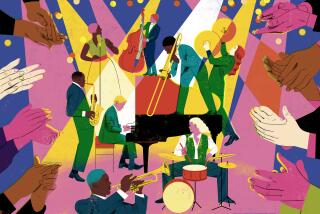JAZZ REVIEW : Trioâs Acoustic Effort Electrifies Crowd at Greek
The unplugged craze reached contemporary jazz at the Greek Theatre on Friday night with the arrival of the Rite of Strings. Assembled for a recording and a summer tour, the all-acoustic group consists of three performers closely associated with electric music: violinist Jean-Luc Ponty, guitarist Al Di Meola and Stanley Clarke, making a rare appearance playing acoustic bass.
But the program was, in fact, only partially acoustic. Ponty, for example, performed a solo number using an electronic device that echoed back his lines in reverberating waves of sound. Di Meola occasionally kicked in a MIDI-triggering unit that added other instrumental samples to his guitar melodies, and Clarkeâs bass sound was pushed to near-percussive intensity via a high-end boost in its amplification.
Not that it mattered all that much. The music produced by the trio was not noticeably different from the kinds of pieces performed in their electric outings. It is music based upon repetitious vamping, group interplay, extended soloing, and compositions driven by contrasting sections, rather than by melody and harmony.
Did it work? For the capacity audience the answer was a rousing âyes.â Leaping to its feet, cheering solo after solo, the noisy, constantly whistling crowd seemed in sync with every note. Each of the musicians--Clarke and Ponty, especially--responded with showboating techniques, reiterating phrases over and over to stimulate more reaction.
From a musical point of view, however, the concert left a great deal to be desired. Missing too often, despite the virtuosic displays of the players, was emotion, imagination and a sense of rhythmic urgency. And, as the audience-pleasing maneuvers increased, whatever creative qualities were present diminished rapidly. By the close of the Rite of Stringsâ program, only Di Meola appeared to still be in touch with the essentials of good jazz.
Most of the concertâs musically appealing moments were provided by Tuck & Patti, the opening act. Often identified as a pop artist, Patti Cathcart sounded a lot more like a potentially first-rate jazz singer. And if the guitar work of Tuck Andress was stylistically undefinable, he demonstrated the jazz playerâs ability to swing past the notes and into the music.
More to Read
The biggest entertainment stories
Get our big stories about Hollywood, film, television, music, arts, culture and more right in your inbox as soon as they publish.
You may occasionally receive promotional content from the Los Angeles Times.










